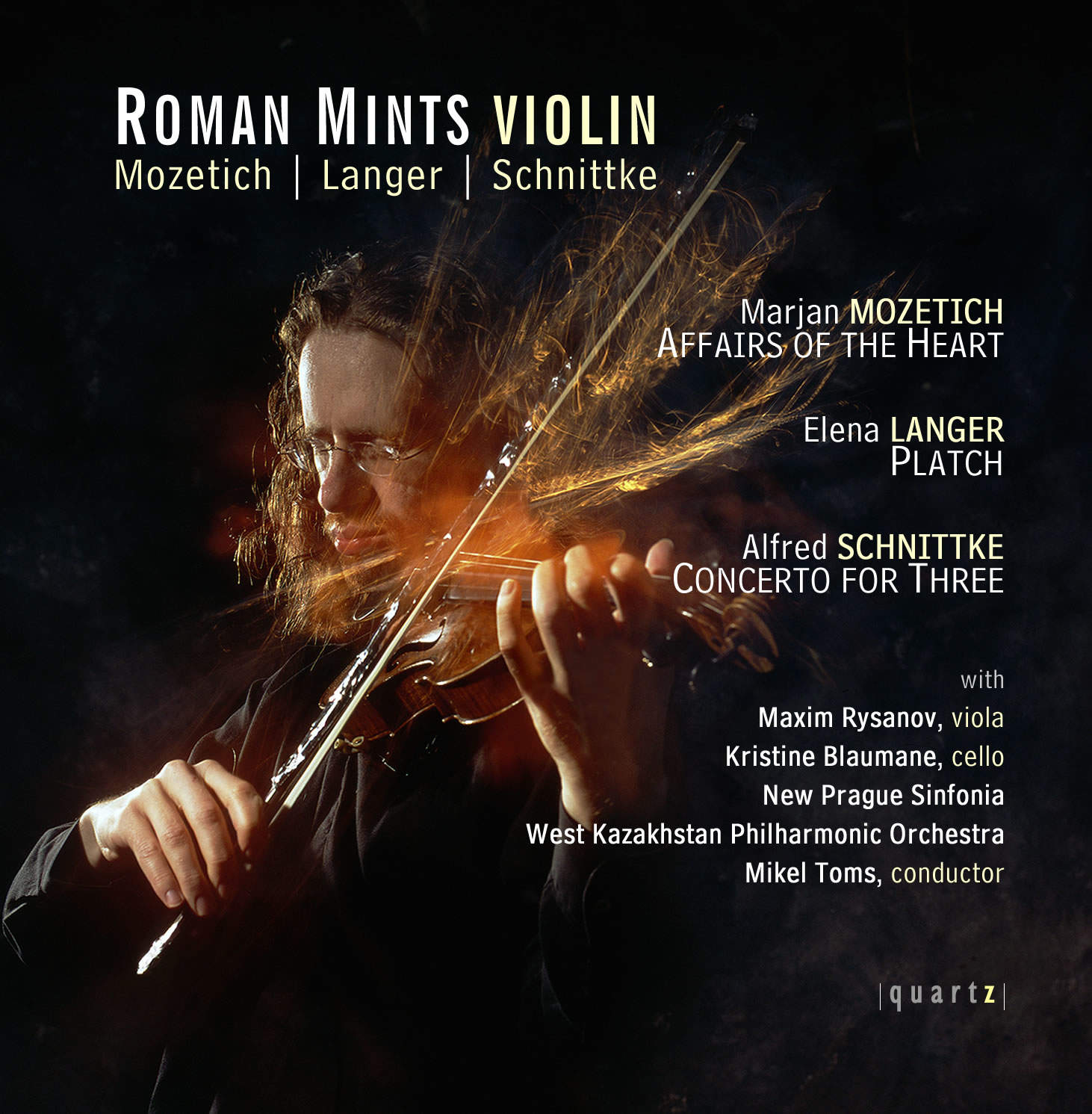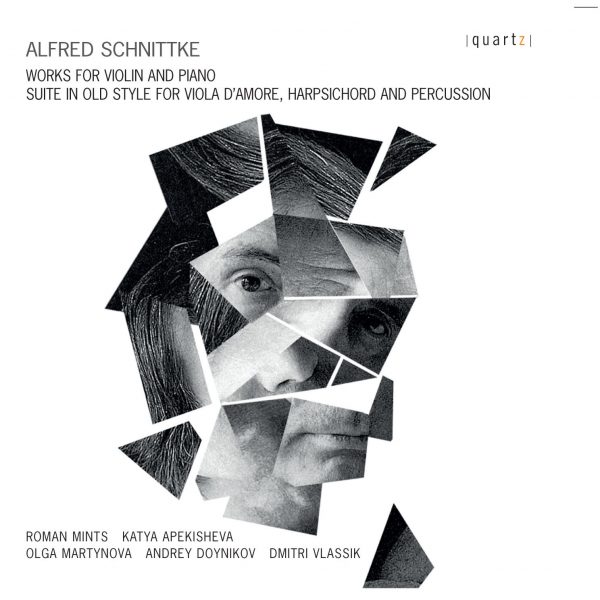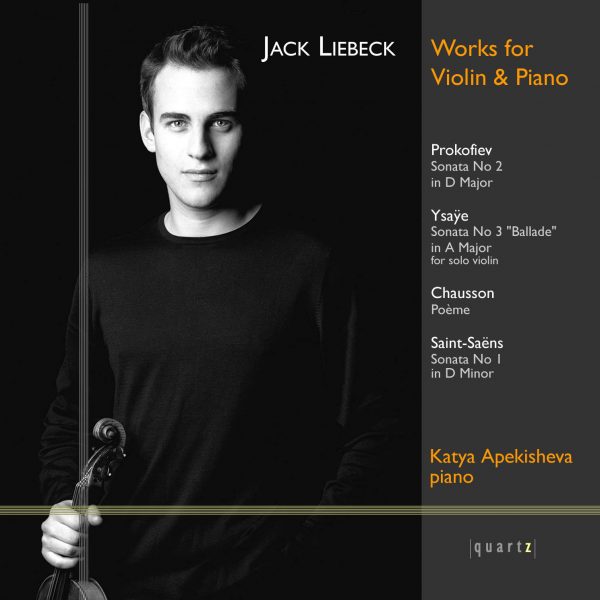Mozetich | Langer | Schnittke
Price range: £4.99 through £11.99
Affairs of the Heart
Concerto for violin and string orchestra
Marjan Mozetich
Platch
for violin and string orchestra
Elena Langer
Concerto for Three
for violin, viola, cello and chamber orchestra
Alfred Schnittke
BONUS TRACK (Hard copy CD only – not download)
Sometimes It Rains
for violin and electronics
Ed Bennett
Roman Mints, violin
with
Maxim Rysanov, viola
Kristine Blaumane, cello
New Prague Sinfonia
West Kazakhstan Philharmonic Orchestra
Mikel Toms, conductor
About This Recording
There are those in the world of contemporary music for whom directly expressed, raw emotion is rather embarrassing; it is shunned in favour of music intended to stimulate the mind rather than touch the heart. Not so with the composers on this disc. For Marjan Mozetich, Elena Langer and Alfred Schnittke, the evocation of deeply-held feelings has been central to their musical styles, and the three works on this disc share this intensity of emotion. The title of Mozetich’s Affairs of the Heart makes explicit the composer’s desire to convey the variety and depth of human emotion, while the tragic death of his friend David Morris, which occurred towards the end of the work’s composition, adds to it a particular poignancy. In Platch, Elena Langer relates the emotional tussle between the joyful union of a wedding, and the sense of loss that the occasion can generate in the hearts of those for whom it is a separation, to be mourned with outpourings of grief. Schnittke’s Concerto for Three was written in 1994, one of the last pieces he wrote before his death in 1998. Like so much of the composer’s late music, it has a bleak beauty that related directly to his ill health, and to the impending prospect of life coming to an end.
Marjan Mozetich, like Schnittke before him, has explored a number of contrasting musical avenues. His early love of the avant-garde stimulated works that plundered all the musical and technical resources that world had to offer, encompassing works scored in graphic notation and the use of non-instrumental objects to create unusual sounds or moments of drama. However, Mozetich moved away from a purely modernist approach; like Schnittke, he had come to find it rather dry, lamenting the apparent necessity for composers to “create a hypothesis and then realise it musically, like a research paper.” Two apparently conflicting elements now outweighed modernism in Mozetich’s sound-world: the minimalist devices of Philip Glass and Steve Reich, and, to the surprise of many, Romanticism. It is these two styles that are most in evidence in the violin concerto Affairs of the Heart.
Commissioned by the Canadian Broadcasting Corporation, Affairs of the Heart was completed on 1 August 1997 – just three years after Schnittke’s Concerto for Three. Mozetich chose not to follow the standard three-movement, virtuosic showcase concerto model, instead allowing the violin a fluid relationship with the orchestra in a single movement which ebbs and flows between different tempi and atmospheres. At the end of the work, the music of the slow introduction returns. It was while Mozetich was writing this passage that he learned of the death of David Morris, to whose memory the work is dedicated.
The devices of minimalism are audibly in evidence during Affairs of the Heart – the explicitly drawn musical evolution is there – yet this is combined with a serene, graceful Romantic freedom, at times even reminiscent of Vaughan Williams’ Lark Ascending, which lifts Mozetich’s music beyond any hint of chugging inevitability, allowing the soloist to soar with unfettered emotion. This quality was instantly recognised by listeners to CBC Radio’s broadcast of the work. The network’s switchboards lit up, and it received many accounts of “the driveway experience”” – when listeners are so entranced by what they are hearing that they remain in their cars until the work’s end, long after they’ve arrived home.
© Joanna Wyld, 2006
Platch is inspired by the ritual of mourning at a traditional Russian wedding. “Platch” in Russian means “crying”. Mourning at a happy event such as a wedding is obviously symbolic and theatrical. Professional mourners were invited for the weddings to perform laments mourning the departure of the bride from her parents’ house. When performing these laments, the mourners would drive themselves to the verge of hysteria. Musically, nuptial laments were close to those heard at funerals (a marriage for a bride symbolised a death to one condition and a transition to another one – which explains why there was a tradition of dressing brides, as well as the deceased, in white clothes).
While composing this piece, I was imagining that the solo violin is a mourner, who drives herself to the point of distraction, and the orchestra – a choir of mourners who emotionally react to the solo and whisper, sigh, talk and holler. My piece contains no direct quotations from this genre; rather, I try to create my own imaginary lament. But in the Coda of the piece, I use as a melodic basis an old Yiddish lullaby which my grandmother used to sing to me. As a composer, it is this area, the creation of a synthetic “folkmusic” free from the specific constraints of any one culture, which I find particularly exciting. Platch is dedicated to a friend of mine, violinist Roman Mints.
© Elena Langer, 2006
Schnittke’s musical journey was characterised by a number of phases. He is considered by many to be the musical heir to Shostakovich, whose influence can be heard in his earliest works. This influence was, for a time, superseded by the use of serial techniques when Schnittke came into contact with Luigi Nono in the 1960s. However, Schnittke soon felt he had outgrown the sometimes arid intellectual rigours of serialism, and began to develop ‘polystylism’, drawing together music from different genres and eras. This technique would dominate his musical output between the later 1960s and early 1980s. Then in 1985, Schnittke suffered a stroke that left him in a coma. He was declared clinically dead on several occasions, and suffered more strokes, but in defiance of this continued to compose until 1994, when another stroke obstructed further progress; he died in 1998. The nature of Schnittke’s music was inevitably affected by the deterioration of his health, and a particular bleakness entered his music in the 1980s. Yet there is determination, too, a characteristic praised by Mstislav Rostropovich, for whom the cello part of the Concerto for Three was written: “we are full of admiration for the dynamite within him that allows him to go on creating in spite of all he has suffered”.
The title of the Concerto for Three specifically avoids the amiable implications of a ‘Triple Concerto’; Schnittke isolates his three protagonists until the final movement, when they enter the fray as combatants more than conversationalists. The work was written for Gidon Kremer, Yuri Bashmet and Mstislav Rostropovich, and Schnittke drew on the names of each to determine the musical material – for instance, he extracted the G, D and Es of Kramer’s name for the opening of the third movement. Interestingly, the score omits dynamic markings, something about which Schnittke had previously been fastidious. Whether intentional or not, this allows the performers substantial freedom of interpretation. The title of the Concerto for Three has a further meaning: in Russian, ‘for three’ ‘ na troikh’ alludes to the tradition of three red-nosed drinkers, sometimes complete strangers, sharing a bottle of vodka to cut the expense – a grim image from which Schnittke derived a certain dark humour.
The first movement is characterised by austere, abrasive writing for solo cello, supported by celli and bass only. The raw, percussive treatment of the cello in this movement shows Schnittke in his modernist guise, eschewing the conventionally lyrical approach to the instrument in favour of bold gestures which find parallels in his Second Cello Sonata, also written for Rostropovich. The second movement, in which the viola takes centre stage, begins with jutting repeated notes later echoed by the ensemble (now slightly augmented to violas, celli and bass), but the soloist also enjoys expansive moments supported by widely-spaced chords, and reflective, discursive material, suggestive of one working through a conundrum. Here, and in the third movement, Schnittke anchors the work with touches of tonality.
It is in the third movement that Schnittke at last begins to use the full ensemble. After a translucent opening texture, the violin part combines sustained lines with declamatory gestures, at times supported by chord clusters on some thirteen strings. In the frenzied finale, all three soloists and their orchestral counterparts battle it out with their different moto perpetuo materials, until the astonishing final gesture: the piano, hitherto entirely witheld, ends the freneticism with a widely-spaced chord, sounding a death knell that immediately curtails the previous excitement. But Schnittke did not quite end the work there. He wrote a Minuet as an encore, and it is in this work that the three soloists at last engage in harmonious conversation. The Minuet offers a last glimpse of Schnittke’s earlier style; it is as though, realising this was to be his swan song, he made one final return to the past.
© Joanna Wyld, 2006
Track Listing
-
Marjan Mozetich
- Affairs of the Heart Elena Langer
- Platch Alfred Schnittke
- Concerto For Three (i) Moderato-Allegretto
- Concerto For Three (ii) (Larghetto)
- Concerto For Three (iii) Largo
- Concerto For Three (iv) Allegro
- Concerto For Three (iv) Menuetto




